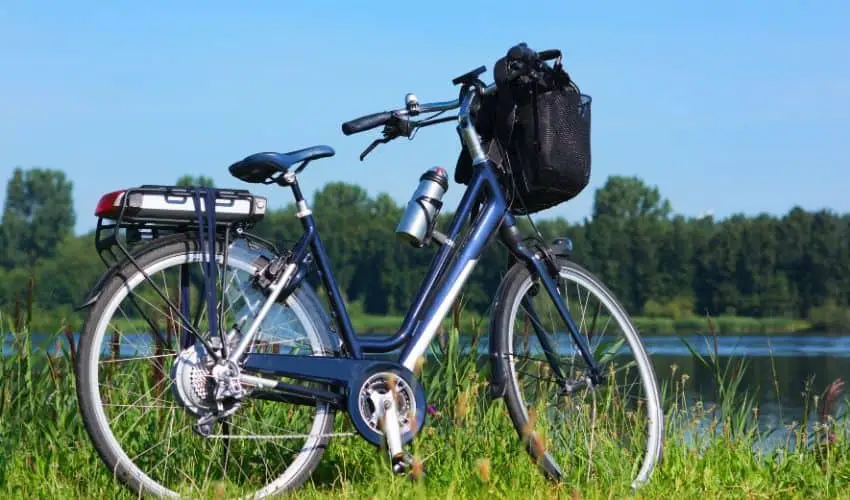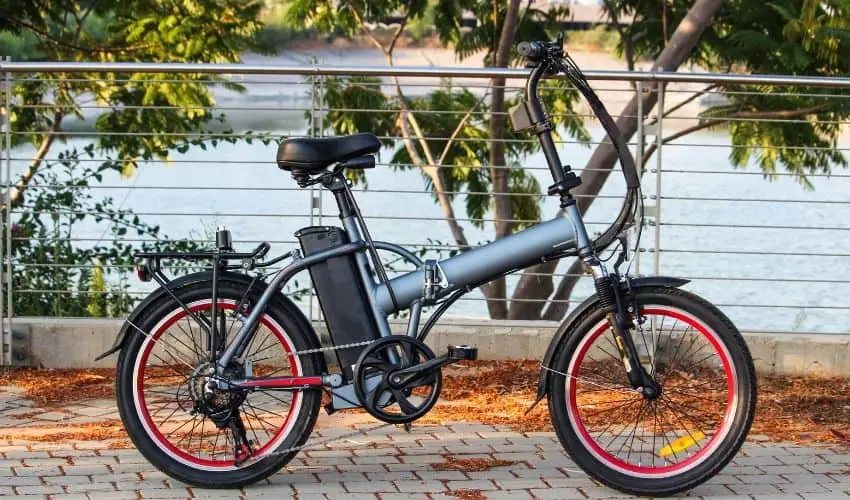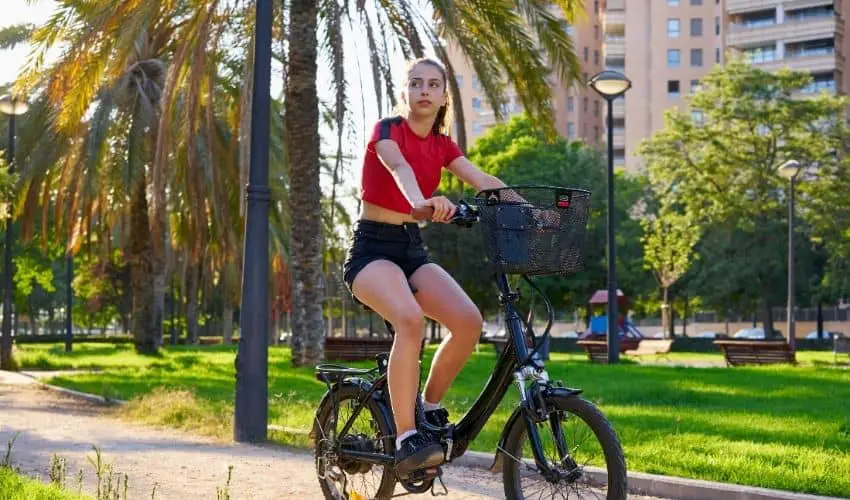The first time you heard of an electric bike, you might have imagined something more along the lines of a motorcycle or electric scooter. You may have thought electric bikes are a type of sports gear that works on its own—as most electric gadgets do.
However, an electric bike actually closely resembles a regular bike. It just has extra parts, such as a motor, a battery, and a controller, which is what converts it from the usual bikes you’ve seen growing up, into the fast-paced vehicle that we see on the streets today.
You may like How to Choose an Electric Bike and Can An Electric Bike Replace A Car?
The major difference between electric bikes and normal bikes is more in the components than the overall look. The introduction of the e-bike isn’t new, but the design and the way people have perceived it has changed drastically over the years.
As the e-bike industry is rapidly growing and more people are adding these convenient vehicles to their collection, it’s important to know exactly what an e-bike is and how they work, so you know which one is best for you.

Here’s what you need to know about what is an electric bike and how it works.
What Is an Electric Bike?
What Is an Electric Bike? An electric bicycle is a bicycle that has an electric motor that enhances its propulsion. Some of them have small motors that add a slight enhancement to your pedaling to make the bike move faster. Others have larger, more powerful motors that allow you to travel distances with only a few pedals or by using the hand throttle.
However, because electric bikes still require you to pedal or use the hand throttle once in a while, they are different from an electric motorcycles, which do not require any pedaling and get their power from fuel.
Regular electric bikes have the ability to go as fast as 16 to 20 m/h. If you have one with a larger motor, it can go as fast as 28 m/h. Depending on where you live, the speed limit for electric bikes can differ. In Canada, your electric bike can go as fast as 32km/h and can only have an output of 500 W.
If you have made any modifications or your bike weighs more than 120 kg, you will not be able to take the e-bike onto the road. Some localities do not require e-bike riders to wear a helmet, but it is compulsory to wear an approved bike or motorcycle helmet while riding an e-bike in Ontario.
While most states allow electric bikes on the same area of the road where regular bikes are operated, they have other restrictions because of their electric motor. For example, people under 16 are not allowed to ride an electric bike in Florida. The speed limit for electric bikes in Florida is 20m/h on level ground.
Some communities, however, have made their own laws about electric bikes with regards to their speed and where they are allowed. Most e-bikes are not allowed on any land that is not a paved road. You do not require an additional license for riding e-bikes, but because of their higher speeds, riders generally need to be cautious of how fast they are going in residential areas.
In New York, you can ride an electric bike that operates under 25 m/h within city limits, with a penalty of $250 if you operate an e-bike in a way that could hurt other people or property. This is a new and promising law given that e-bikes were strictly regulated and confiscated, with penalties as much as $500 in previous years.
While some cycle enthusiasts may find that electric bikes do not provide the same level of exercise as regular bikes because of their infrequent pedaling, they are popular for the longer distances they can go and for the ease they provide when you’re riding up a hill or trying to commute to work without tiring yourself out.
In fact, because e-bikes need 64% lesser energy than walking and 22% lesser energy than riding a regular bike, they appeal to a whole new range of people that want to enjoy the sport without overexerting themselves. They’re also environmentally friendly, like regular bikes, because they do not need gas or fuel to function. They get their power from the rider’s pedals and are also noiseless.
How Do Electric Bikes Work?
As mentioned above, electric bikes differ from regular bikes because of their added components. However, not every e-bike’s parts are the same, and depending on which kind of electric bike you end up investing in, it could be faster or slower and require different levels of energy input from you.
Some e-bikes come with a hand throttle and do not require pedaling, while some rely on the energy input they get from pedaling in order to propel you forward.
E-bikes also come in different models for riding up steep surfaces, traveling long distances on city roads, or just casually riding around the street. Their power rating can differ, with some having a rating as high as 1,000W. However, if you’re in the US, the legal limit is 750W, while in Canada, it is even lower, as stated above.
Here’s what you need to know about how the different parts of an electric bike come together to make it work.

The Motor
The higher the rating of a motor, the more battery it drains in a shorter amount of time. However, a 750W motor is going to be much more powerful than a 250W motor. There’s more to the motor than just its rating. Where it is located on the bike and the way it is designed plays a role in how your e-bike works.
Hub Motor
E-bikes that have the motor integrated into the back of the front of wheel are the most common. These kinds of motors are called hub motors, or front wheel motors and pull or push the wheel in order to move the e-bike. They’re good for riding around town and are more affordable.
However, the main drawback of using a hub motor is that it is not connected to the gears of your e-bike. This means that these kinds of electric bikes do not work well when you are trying to go up a steep hill or a terrain with a rough surface. This also means that the bike doesn’t go as fast as a bike with a mid-drive motor, which works in connection with the crank and the gears.
Mid-Drive Motor
A mid-drive or a center-mount motor uses less energy from the battery because it also gets power from the e-bike’s gears. It is also more convenient to ride up a hill and has a substantial amount of climbing power.
These motors allow the e-bike to give you ample assistance when navigating up steep terrain and are more sensitive to the amount of power you need. Hence, they provide varying amounts of power according to what you need to get through a climb. You can change gears when inclining, which gives you more control and steadiness through a difficult climb.
A mid-drive motor has a low center of gravity, which makes it a good addition to your gear if you are into mountain climbing. These bikes are easier to control and give you enhanced torque and speed.
Rear Wheel Motor
Electric bikes with rear-wheel motors are easy to handle and have exceptional traction. They have a different design which does not automatically give away that you’re riding an e-bike, because they look closer to a regular bike due to the placement of the motor. They also have lighter weight and have a smooth and noiseless operating system.
The Battery
There are two main kinds of batteries that are used in electric bikes. The battery, like the motor, impacts the e-bike’s weight and style, while also influencing the kind of range it has. This is why it is very important to know what you’re looking for in a potential e-bike so that you know which kind of battery is best for you.
Here’s what you need to know about electric bike batteries.
Sealed Lead Acid Battery
The original batteries used for most electric bikes and scooters were the sealed lead-acid batteries. However, for a number of reasons, electric bikes now incorporate other battery types as well, while electric scooters continue to rely on SLA batteries.
The advantage of using an SLA battery powered electric bike is that these are more affordable. However, they are heavier than other e-bikes, which can become a problem especially when you are trying to remain within the weight limits of your region for e-bikes.
They also do not function for longer distances, which means that if you are looking for a bike that provides assistance through longer commutes, you might struggle to use an SLA battery-powered bike. The lifespan of the battery is only as much as 300 full charges, which is fewer than electric bikes that use an alternative to SLA batteries.
They also need to be charged quite often—so you have to charge them as soon as you’re done using them, which can become high maintenance for some users.
Lithium Battery
The lithium battery includes ion, polymer, and manganese and is the kind of battery being used in most newer models of electric bikes. These not only have triple the lifespan of an SLA battery, they require significantly less maintenance and are much lighter in weight, making them easier to use.
The advantages of going for a lithium battery powered electric bike is that they have a very high capacity compared to their size and weight. For instance, a 36V10Ah lithium-polymer battery only weighs 6 pounds, allowing you to ride your electric bike longer distance without tiring yourself out.
They are also better for long commutes, with a range of as much as 40 miles in one go if you use the pedals. If you use the throttle, they can go up to 20 miles, which means they require less power and can travel longer distances.
One major advantage of using a lithium battery powered electric bike is that it can be charged as many as 800 times, which means you can use the same battery for around three years, regularly, without needing to replace it.
However, these bikes are much more expensive than SLA battery powered bikes. If you’re willing to make the investment keeping in mind the long-term benefits, this battery is a smarter choice for you.
The Controller
The last essential part of an electric bike is the controller. This is what helps you navigate the electric assistance on the bike and is typically found on the handlebar. The two most common kinds of controllers are the pedal and the throttle based controllers.
The difference between the two is that a pedal activated control requires you to push down on the pedal in order to get power through the electric assistance. With a throttle based controller, you only need to pedal.
With a pedal-activated electric bike, you can use the controller to vary the amount of assistance you want when you pedal, which means you can adjust it based on how far or how fast you want to go and how much energy you want to use up.
With a throttle based controller, because the throttle is placed on the handlebar, all you have to do is press or twist the button to get electric assistance. In fact, depending on the kind of electric bike you get, if you turn the throttle on, you can ride the bike and go long distances without having to pedal at all.
What Else Do You Need to Know Using an Electric Bike?
Last but not least, there are three different ways that you can use an electric bike. When going to purchase an e-bike of your own, you will want to know if you have all three options available to you within one bike, or if it performs better in a certain mode only.

Here’s what you need to know about the three different modes available on an electrical bike.
Pedal
If you’re looking for a bike that you can use both for mountain climbing and rigorous exercise, while also being able to use it as a normal bike, you will want a bike that has the pedal only option.
You can use it as a regular bike and rely only on the pedals to move. The way that electric bikes are designed, you are not going to have any trouble with the motor in terms of resistance if you decide to switch to pedal-only every once in a while.
Because an electric bike is not a regular bike, you still get the option of changing gears and changing your speed depending on where you are or the kind of terrain you are on—which is why it is still more convenient than a regular bike.
Electric Assist
The second way of using an electric bike is with the pedal-assist. Most people prefer this way of using an electric bike because it works as a combination of both a regular bike mixed with electric power for added distance and lesser energy consumption by you.
All you have to do is maneuver the controller and determine how much power you want the electric assistance to give you, which will determine how much energy you have to put in in terms of pedaling. There are typically three different levels: high, medium, and low.
Electric
The last option for electric bikes is the electric-only option. When an e-bike operates on this mode, you do not have to pedal at all because the motor provides the energy that is needed to operate the electric bike. In this option, you just have to use the controller to activate the throttle.
The motor will start up and start moving your electric bike, but you have to keep an eye on the speed and will have to turn it off when you want the bike to halt or if you want to switch to one of the other modes.
You may like the following e-bike articles:
- Best Off-Road Electric Bikes for 2020
- Best Dual Motor Electric Bikes for 2020
- Best Electric Bikes Under $2000
- Best Fat Tire Electric Bikes
- Best Electric Bikes Under $1000
- Which Electric Bike has the Longest Range?
- 6 Best Electric Bikes under $500
- Best Electric Bikes for Kids
- Best Electric Bikes for Women
Final Words
Electric bikes can range from very expensive to relatively affordable, depending on the kind of options, battery, weight, modes, and gears you have in the e-bike that you are opting for. Because of the kind of investment they are, it is important to make sure that you know the specifics of the bike you are purchasing—does it have the navigation and ease that you are looking for?
Does it allow you to commute to work or go camping in places with rough terrain and steep hills? When you know what you need in the electric bike you want to purchase, you can find a model that aligns with your goals and make it a worthwhile investment. You should also check with the regulation and limitations in your area before settling with a certain e-bike. While most states do not require a license, you will have to make sure the speed and weight limits are in accordance with the city you are planning to operate the e-bike in.

I am Michael, an avid rider and bike expert. I am here to provide, biking tips and expert advice on in-depth bike reviews covering features, capabilities, price range, and much more. Specially on electric bikes, mountain bikes, road bikes, etc. I will provide honest product reviews, along with expert advice on purchasing, training, and maintenance. Check out my complete profile.

